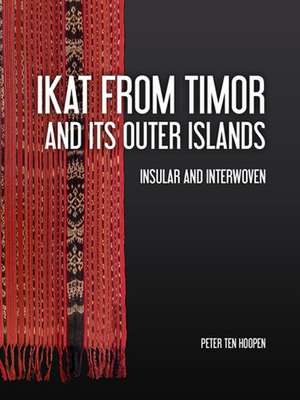Ikat from Timor and its outer Islands
Autor Peter Ten Hoopenen Limba Engleză Paperback – 18 mai 2022
Asymmetry is widely distributed in the region, yet has largely been ignored. This is curious, because asymmetry is highly interesting: it goes against ikat's technical diktat (which prescribes the production of two identical panels in parallel), hence requires extra work. Seven distinct ways to achieve asymmetry are differentiated, including visual tricks and illusions, flagrant displays of virtuosity, and intellectual superiority. On Sumba, women of the nobility made thrilling and amusing efforts to hide their virtuosity, dyeing into their men's cloths tiny visual devices, secret keys, which revealed that their work was not just good, but luar biasa, out of the ordinary. Ironically, because these late 19th- and early 20th-century dyers were such great masters at hiding their virtuosity, it remained overlooked by generations of researchers.
Taking up Marie Jeanne Adams's 1969 call, so far unheeded, to deepen the study of Indonesian ikat textiles by means of microscopy, the author shot thousands of micro-photographs, allowing a study of yarn development over time, as well as the differentiation of 21 distinct weave types, a number far exceeding expectation, and their distribution across 41 ikat weaving regions in the Indonesian archipelago.
In the final chapter, the author analyses what may have spurred the weavers of the region to create their most intricate, most time consuming, feats of artistry, and develops a view of these women as far more inventive and intelligent than they have been credited with before - and more assertive, using ikat's prestige to spin their men into a web of taboos and prescriptions.
Preț: 480.28 lei
Preț vechi: 565.04 lei
-15% Nou
Puncte Express: 720
Preț estimativ în valută:
91.90€ • 98.27$ • 76.63£
91.90€ • 98.27$ • 76.63£
Carte tipărită la comandă
Livrare economică 14-19 aprilie
Preluare comenzi: 021 569.72.76
Specificații
ISBN-13: 9789464280128
ISBN-10: 9464280123
Pagini: 318
Ilustrații: 350fc/5bw
Dimensiuni: 210 x 280 x 21 mm
Greutate: 1.04 kg
Editura: Sidestone Press Dissertations
ISBN-10: 9464280123
Pagini: 318
Ilustrații: 350fc/5bw
Dimensiuni: 210 x 280 x 21 mm
Greutate: 1.04 kg
Editura: Sidestone Press Dissertations
Notă biografică
From 1968 to 1971 Dr. Peter ten Hoopen lived in and travelled through the Middle East and South Asia, conducting journalistic research and recording ethnic music in Afghanistan, now curated by the Smithsonian Institution (Washington, DC). During his extensive travels in 65 countries in subsequent years he witnessed the ongoing decline of numerous indigenous traditions. This experience affected him deeply and in 1976 led to his initiative to assemble a reference collection of particularly imperilled Indonesian ikat textiles ¿ meticulously documented on a level not previously attempted. Since his retirement in 2010 Peter ten Hoopen has been focussing on documenting of the above-mentioned, by then extensive reference collection of Indonesian ikat textiles. This has led to major exhibitions at the Museu do Oriente in Lisbon (2014-2015 and 2019-2020) and at the Museum and Art Gallery, the University of Hong Kong (2017-2018), for which he authored or edited the catalogues. His collecting and documenting since the mid-1970s culminated in the publication of his Ikat Textiles of the Indonesian Archipelago (2018) and the research reported in the present PhD thesis.
Descriere
This is the first study to focus on ikat of the Timor region from a technical perspective, including microscopy and design analysis of asymmetry, an understudied subject.
